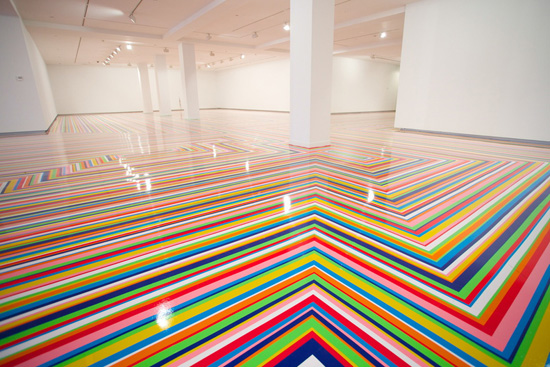From Sharne Wolff…
The first artwork you’re likely to see when arriving on Cockatoo Island is Callum Morton’s The Other Side. In pop art-style a massive billboard carries an image of the ubiquitous Google home page, unrecognisable 20 years ago, and comes complete with its own ‘search engine’ (a scaled-down train). Festival Director Juliana Engberg envisages the Island as a “fantasy location” – expressed as either utopia or dystopia. Numerous works on the Island’s already fabulous industrial precinct take on the challenge, and the constant question – ‘is this art?’ – adds to the allure. Joseph Griffith’s Ruins, installed outside, is a good example of this effect. Inside the ex-Turbine Shop, Tori Wranes Stone and Singer made for a compelling performance beneath an enormous swinging boulder. Its backdrop, Eva Koch’s majestic waterfall video is no less captivating as it cascades from the roof, juxtaposed against the industrial might of this place – once the largest building in the southern hemisphere. Both Randi & Katrine’s fortified fairytale village and Gerda Steiner & Jorg Lenzlinger’s colourful Bush Power gym are arm-pulling installations impossible to miss.
On the docks Mikala Dwyer’s The Hollows, are sculpted floaty forms of translucent plastic that make beautiful use of space, as does Ulla Von Brandenberg’s installation, Street, Play Way, where the viewer is encouraged to walk through a theatrical cavalcade of hanging sail ‘curtains’ to view a video.
In the convict quarter, dark spaces and sandstone cubbyholes provide eerie spaces for viewing more video works while Zilla Leutenegger’s Zilla’s house comes complete with its own cast of ghostly shadows. The dystopian theme is continued in Ignas Krunglevicius’s chilling Interrogation video work based on the transcript of a 2004 US murder investigation.
Back at the MCA, Engberg’s ‘surrealist ride’ begins with Pipilotti Rist’s dreamy Mercy, Garden Retour Skin where viewers are encouraged to lay on floor cushions and immerse themselves in a room-filling six-channel video. If that’s not dazzling enough, Jim Lambie’s Zobop installation saturates the entire ground floor in a psychedelic glow. Meanwhile, TV Moore’s trippy abstract photo-paintings and Hubert Czerepok’s circular neon installation Madness Is Like Gravity advance the hallucinogenic atmosphere upstairs. Douglas Gordon’s Phantom – a dark and intimate installation of two pianos (one burnt) and a moist oversize eye opening and closing slowly to Rufus Wainwright’s hymnal soundtrack quietens the pace but probably ups the intensity in its all-enveloping way. Throwing to the “stillness” in Engberg’s theme are Aurelian Froment’s long series of black and white photographs Tombeau de Ferdinand Cheval shot at the incredible handbuilt ‘dream home’ of a French postman while Roni Horn’s bewildering Ten Liquid Incidents of solid glass are meditative and nicely reflective of the viewer.
Until June 9
Cockatoo Island
MCAThe Rocks
Pic: Jim Lambie, Zobop, 2014. Vinyl tape, varnish, dimensions variable. Installation view of the 19th Biennale of Sydney at the Museum of Contemporary Art Australia. Courtesy the artist and The Modern Institute/Toby Webster Ltd, Glasgow. Created for the 19th Biennale of Sydney Photograph: Ben Symons.

